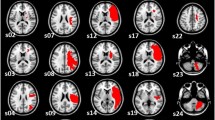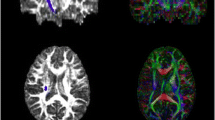Abstract
Purpose
Despite improved acute treatment and new tools to facilitate recovery, most patients have motor deficits after stroke, often causing disability. However, motor impairment varies considerably among patients, and recovery in the acute/subacute phase is difficult to predict using clinical measures alone, particularly in severely impaired patients. Accurate early prediction of recovery would help rationalize rehabilitation goals and improve the design of trials testing strategies to facilitate recovery.
Methods
We review the role of diffusion tensor imaging (DTI) in predicting motor recovery after stroke, in monitoring treatment response, and in evaluating white matter remodeling. We critically appraise DTI studies and discuss their limitations, and we explore directions for future study.
Results
Growing evidence suggests that combining clinical scores with information about corticospinal tract (CST) integrity can improve predictions about motor outcome. The extent of CST damage on DTI and/or the overlap between the CST and a lesion are key prognostic factor that determines motor performance and outcome. Three main strategies to quantify stroke-related CST damage have been proposed: (i) measuring FA distal to the stroke area, (ii) measuring the number of fibers that go through the stroke with tractography, and (iii) measuring the overlap between the stroke and a CST map derived from healthy age- and gender-matched controls.
Conclusion
Recovery of motor function probably involves remodeling of the CST proper and/or a greater reliance on alternative motor tracts through spontaneous and treatment-induced plasticity. DTI-metrics represent promising clinical biomarkers to predict motor recovery and to monitor and predict the response to neurorehabilitative interventions.

Similar content being viewed by others
References
Go AS, Mozaffarian D, Roger VL et al (2013) Heart disease and stroke statistics–2013 update: a report from the American Heart Association. Circulation 127:e6–e245
Ayis S, Wellwood I, Rudd AG et al (2015) Variations in health-related quality of life (HRQoL) and survival 1 year after stroke: five European population-based registers. BMJ Open 5:e007101
Prabhakaran S, Zarahn E, Riley C et al (2008) Inter-individual variability in the capacity for motor recovery after ischemic stroke. Neurorehabil Neural Repair 22:64–71
Winters C, van Wegen EE, Daffertshofer A, Kwakkel G (2015) Generalizability of the proportional recovery model for the upper extremity after an ischemic stroke. Neurorehabil Neural Repair 29:614–622
Coupar F, Pollock A, Rowe P et al (2012) Predictors of upper limb recovery after stroke: a systematic review and meta-analysis. Clin Rehabil 26:291–313
Hendricks HT, van Limbeek J, Geurts AC et al (2002) Motor recovery after stroke: a systematic review of the literature. Arch Phys Med Rehabil 83:1629–1637
Koh CL, Pan SL, Jeng JS, Chen BB, Wang YH, Hsueh IP, Hsieh CL (2015) Predicting recovery of voluntary upper extremity movement in subacute stroke patients with severe upper extremity paresis. PLoS One 10(5):e0126857
Stinear C (2010) Prediction of recovery of motor function after stroke. Lancet Neurol 9:1228–1232
Stinear CM, Ward NS (2013) How useful is imaging in predicting outcomes in stroke rehabilitation? Int J Stroke 8:33–37
Mukherjee P, Berman JI, Chung SW et al (2008a) Diffusion tensor MR imaging and fiber tractography: theoretic underpinnings. AJNR Am J Neuroradiol 29:632–641
Mukherjee P, Chung SW, Berman JI et al (2008b) Diffusion tensor MR imaging and fiber tractography: technical considerations. AJNR Am J Neuroradiol 29:843–852
Byblow WD, Stinear CM, Barber PA, Petoe MA, Ackerley SJ (2015) Proportional recovery after stroke depends on corticomotor integrity. Ann Neurol 78:848–859
Puig J, Blasco G, Daunis-i-Estadella J et al (2013) Decreased corticospinal tract fractional anisotropy predicts long-term motor outcome after stroke. Stroke 44:2016–2018
Stinear CM, Barber PA, Petoe M et al (2012) The PREP algorithm predicts potential for upper limb recovery after stroke. Brain 135:2527–2535
Puig J, Pedraza S, Blasco G et al (2010) Wallerian degeneration in the corticospinal tract evaluated by diffusion tensor imaging correlates with motor deficit 30 days after middle cerebral artery ischemic stroke. AJNR Am J Neuroradiol 31:1324–1330
Thomalla G, Glauche V, Koch MA et al (2004) Diffusion tensor imaging detects early Wallerian degeneration of the pyramidal tract after ischemic stroke. NeuroImage 22:1767–1774
Kumar P, Kathuria P, Nair P, Prasad K (2016) Prediction of upper limb motor recovery after subacute ischemic stroke using diffusion tensor imaging: a systematic review and meta-analysis. J Stroke 18:50–59
Lindenberg R, Zhu LL, Rüber T et al (2012) Predicting functional motor potential in chronic stroke patients using diffusion tensor imaging. Hum Brain Mapp 33:1040–1051
Stinear CM, Barber PA, Smale PR et al (2007) Functional potential in chronic stroke patients depends on corticospinal tract integrity. Brain 130:170–180
Schaechter JD, Fricker ZP, Perdue KL et al (2009) Microstructural status of ipsilesional and contralesional corticospinal tract correlates with motor skill in chronic stroke patients. Hum Brain Mapp 30:3461–3474
Song J, Nair VA, Young BM et al (2015) DTI measures track and predict motor function outcomes in stroke rehabilitation utilizing BCI technology. Front Hum Neurosci 27:9–195
Borich MR, Brown KE, Boyd LA (2014) Motor skill learning is associated with diffusion characteristics of white matter in individuals with chronic stroke. J Neurol Phys Ther 38:151–160
Lindenberg R, Renga V, Zhu LL et al (2010a) Structural integrity of corticospinal motor fibers predicts motor impairment in chronic stroke. Neurology 74:280–287
Maraka S, Jiang Q, Jafari-Khouzani K et al (2014) Degree of corticospinal tract damage correlates with motor function after stroke. Ann Clin Transl Neurol 1:891–899
Bigourdan A, Munsch F, Coupé P et al (2016) Early fiber number ratio is a surrogate of corticospinal tract integrity and predicts motor recovery after stroke. Stroke 47:1053–1059
Feng W, Wang J, Chhatbar PY et al (2015) Corticospinal tract lesion load: an imaging biomarker for stroke motor outcomes. Ann Neurol 78:860–870
Doughty C, Wang J, Feng W, Hackney D, Pani E, Schlaug G (2016) Detection and predictive value of fractional anisotropy changes of the corticospinal tract in the acute phase of a stroke. Stroke 47:1520–1526
Zhu LL, Lindenberg R, Alexander MP et al (2010) Lesion load of the corticospinal tract predicts motor impairment in chronic stroke. Stroke 41:910–915
Sterr A, Shen S, Szameitat AJ et al (2010) The role of corticospinal tract damage in chronic motor recovery and neurorehabilitation: a pilot study. Neurorehabil Neural Repair 24:413–419
Groisser BN, Copen WA, Singhal AB et al (2014) Corticospinal tract diffusion abnormalities early after stroke predict motor outcome. Neurorehabil Neural Repair 28:751–760
Sterr A, Dean PJ, Szameitat AJ et al (2014) Corticospinal tract integrity and lesion volume play different roles in chronic hemiparesis and its improvement through motor practice. Neurorehabil Neural Repair 28:335–343
Langhorne P, Coupar F, Pollock A (2009) Motor recovery after stroke: a systematic review. Lancet Neurol 8:741–754
Kwakkel G, Kollen BJ (2013) Predicting activities after stroke: what is clinically relevant? Int J Stroke 8:25–32
Murphy TH, Corbett D (2009) Plasticity during stroke recovery: from synapse to behaviour. Nat Rev Neurosci 10:861–872
Stinear CM, Byblow WD (2014) Predicting and accelerating motor recovery after stroke. Curr Opin Neurol 27:624–630
AVERT Trial Collaboration group, Bernhardt J, Langhorne P et al (2015) Efficacy and safety of very early mobilisation within 24 h of stroke onset (AVERT): a randomised controlled trial. Lancet 386:46–55
Davidoff RA (1990) The pyramidal tract. Neurology 40:332–339
Puig J, Pedraza S, Blasco G et al (2011) Acute damage to the posterior limb of the internal capsule on diffusion tensor tractography as an early imaging predictor of motor outcome after stroke. AJNR Am J Neuroradiol 32:857–863
Kim B, Winstein C (2017) Can neurological biomarkers of brain impairment be used to predict poststroke motor recovery? A systematic review. Neurorehabil Neural Repair 31:3–24
Lindenberg R, Renga V, Zhu LL, Nair D, Schlaug G (2010b) Bihemispheric brain stimulation facilitates motor recovery in chronic stroke patients. Neurology 75:2176–2184
Chen JL, Schlaug G (2016) Increased resting state connectivity between ipsilesional motor cortex and contralesional premotor cortex after transcranial direct current stimulation with physical therapy. Sci Rep 16:6–23271
Stinear C, Ackerley S, Byblow W (2013) Rehabilitation is initiated early after stroke, but most motor rehabilitation trials are not: a systematic review. Stroke 44:2039–2065
Wolf SL, Winstein CJ, Miller JP, EXCITE Investigators et al (2006) Effect of constraint-induced movement therapy on upper extremity function 3 to 9 months after stroke: the EXCITE randomized clinical trial. JAMA 296:2095–2104
Savitz SI, Cramer SC, Wechsler L et al (2014) Stem cells as an emerging paradigm in stroke 3: enhancing the development of clinical trials. Stroke 45:634–639
Li Y, Chen J, Zhang CL et al (2005) Gliosis and brain remodeling after treatment of stroke in rats with marrow stromal cells. Glia 49:407–417
Jiang Q, Zhang ZG, Ding GL et al (2006) MRI detects white matter reorganization after neural progenitor cell treatment of stroke. NeuroImage 32:1080–1089
Jiang Q, Zhang ZG, Chopp M (2010) MRI evaluation of white matter recovery after brain injury. Stroke 41:S112–S113
Fozouni N, Chopp M, Nejad-Davarani SP et al (2013) Characterizing brain structures and remodeling after TBI based on information content, diffusion entropy. PLoS One 15:8–e76343
Jones DK, Knosche TR, Turner R (2013) White matter integrity, fiber count, and other fallacies: the do’s and don’ts of diffusion MRI. NeuroImage 73:239–254
Kou N, Park CH, Seghier ML et al (2013) Can fully automated detection of corticospinal tract damage be used in stroke patients? Neurology 80:2242–2245
Pannek K, Chalk JB, Finnigan S, Rose SE (2009) Dynamic corticospinal white matter connectivity changes during stroke recovery: a diffusion tensor probabilistic tractography study. J Magn Reson Imaging 29:529–536
Crocker T, Forster A, Young J et al (2013) Physical rehabilitation for older people in long-term care. Cochrane Database Syst Rev 28:2–CD004294
Yang M, Yang YR, Li HJ et al (2015) Combining diffusion tensor imaging and gray matter volumetry to investigate motor functioning in chronic stroke. PLoS One 12:10–e0125038
Author information
Authors and Affiliations
Corresponding author
Ethics declarations
Funding
This study was funded by a grant from the Spanish Ministry of Health (Fondo de Investigaciones Sanitarias, Reference PI060745).
Conflict of interest
The authors declare that they have no conflict of interest.
Ethical approval
All procedures performed in studies involving human participants were in accordance with the ethical standards of the institutional and/or national research committee and with the 1964 Helsinki Declaration and its later amendments or comparable ethical standards.
Informed consent
Informed consent was obtained from all individual participants included in the study.
Rights and permissions
About this article
Cite this article
Puig, J., Blasco, G., Schlaug, G. et al. Diffusion tensor imaging as a prognostic biomarker for motor recovery and rehabilitation after stroke. Neuroradiology 59, 343–351 (2017). https://doi.org/10.1007/s00234-017-1816-0
Received:
Accepted:
Published:
Issue Date:
DOI: https://doi.org/10.1007/s00234-017-1816-0




